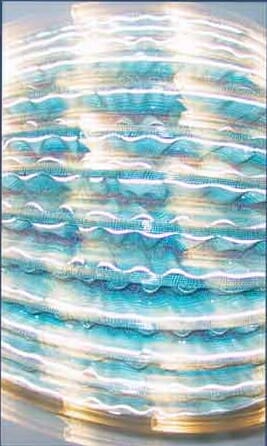Here’s an interesting project by a student at Dublin’s National College of Art and Design. Sharon Butler was inspired by the shapes and colours of medusoid jellyfish, with their intricate structures and bio-luminescent properties, and decided to try to capture this form in a novel table lamp. To simulate the bio-luminscent filaments within the jellyfish she chose to use bare polymer optical fibre, selecting our 0.75mm material.
The flexible optical fibre is woven into the pleated folds of fabric.


“Due to the coming ban on regular light bulbs and the danger of over heating I used a C.F.L Bulb inside a metal cylinder as a light source,” Sharon told us. “It doesn’t heat up much, and it creates a nice warm yellow glow from the fibre optics. The fibre optics do light up well, but it has to be in a dimly lit area to see its full potential as mood lighting.”
That’s very true, since sideglow effects can be easily overwhelmed by bright ambient lighting, so as a rule you are always best to err on the generous side when specifying any type of sideglow fibre installation. In other words, use the thickest fibre and the brightest light source within your budget, so as to avoid disappointment. Sharon’s homemade light source doesn’t feature any twinkle wheel, which is a shame since flickering effects seem to be quite common in the bioluminescence of such marine creatures.


If you’re intrigued by Sharon’s design and would like to commission her to work on a bespoke piece of designer lighting, we’ll be happy to supply her contact details, which she has provided us for this use.
